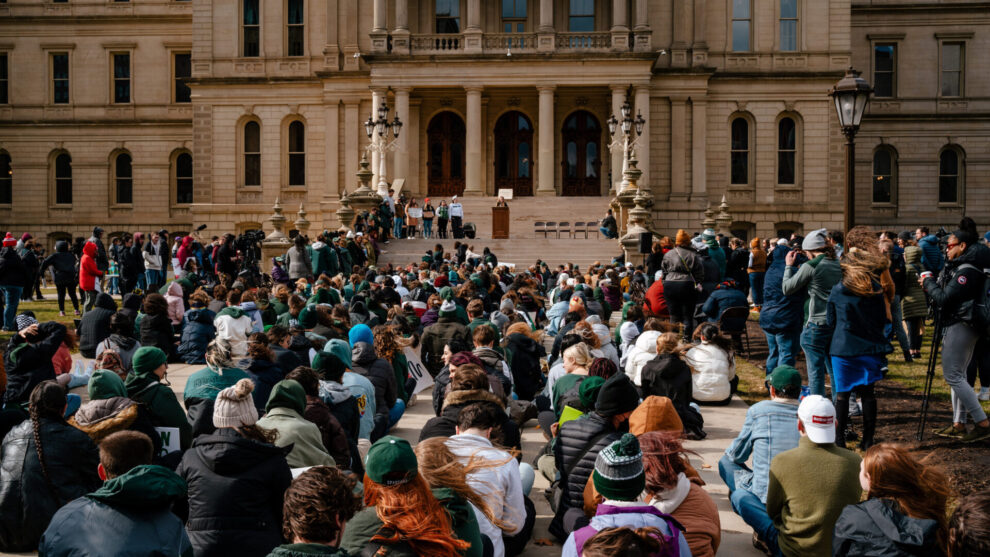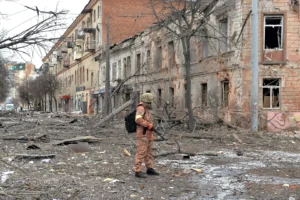EAST LANSING, Mich. — Until a gunman shot and killed three Michigan State University students this week, the campus was a whirl of activity where 50,000 students came and went as they pleased on foot, bike, scooter and bus from dormitories to classrooms to libraries.
But on Wednesday, it was a place for hushed vigils, remembrance and reflection, and where yellow police tape stretched in front of the student union. Classes were canceled as students and faculty tried to balance the freedom of campus life with the sudden reminder that in a country flooded with guns, securing college campuses from random attacks can be an especially vexing challenge.
While elementary, middle and high schools in the United States have been transformed in the last generation — with only moderate success — by metal detectors, new security systems, increased screening for visitors and the installation of locks on classroom doors to evade mass shooters, the same changes have not come to colleges and universities.
“What we do and what is acceptable from K through 12 is not necessarily acceptable when you get to the college level,” said Anthony Gentile, a professor at John Jay College of Criminal Justice and security adviser to the Newtown Public School District, where the Sandy Hook Elementary School massacre occurred in 2012. “Frankly, anybody can drift onto one of the campuses and do what happened the other day.”
That vulnerability was made hauntingly apparent in the wake of Monday’s attack by the gunman, identified by the authorities as Anthony McRae, a 43-year-old who appeared to have no known affiliation with the university. In addition to the three dead, five students who were shot on Monday remained hospitalized in critical condition.
Hundreds of students, braving cold weather and fierce winds, gathered on Wednesday night for a vigil on campus. After a performer sang “You’ll Never Walk Alone,” those gathered were addressed by Gov. Gretchen Whitmer; Teresa Woodruff, the interim university president; Tom Izzo, the men’s basketball coach; and two student leaders. “Our loss has been great,” Mr. Izzo said. “Our lives have been permanently changed, but with a shared commitment to help each other.”
Some students said this week that they wished the campus had tighter security measures, such as requiring key cards or photo identification to enter the student union. Others were skeptical that those kinds of steps would have prevented the attack.

At least one person promoted the notion of allowing guns on campus, scrawling a message on the Rock, a campus landmark that is frequently painted and repainted: “Allow us to defend ourselves & carry on campus.”
On Wednesday afternoon, Ally Anderson, a senior, stood in front of the Rock, quietly paying her respects to the students who were killed before she would leave campus and drive home to Danville, Ky. The message supporting concealed carry had already been painted over.
“I think it’s, like, really insensitive at the moment,” Ms. Anderson said. “It feels like there’s already so many guns, that if they did help, we would have been safe.”
Sarah Forsyth, 18, a freshman studying communications, was in her dorm room on Monday night when she heard of the shooting on campus. She felt safe there, she said, because a student ID is required to enter each floor of the dorm.
But other parts of campus, such as the student union and classroom buildings, are generally open to the public, Ms. Forsyth said.
“Before all this happened, I never felt there was any threat to safety or anything like that,” she said. “I felt very secure on campus.”
David Carter, a professor at Michigan State who is an expert on policing, said that in general, American college campuses are still extraordinarily safe places, and that limiting access was both impractical and antithetical to the spirit of openness at universities.
“If we have completely secure buildings at a university, that seems to undermine our academic freedom, and freedom and thought that we want,” he said. “You’re dealing with adults, not schoolchildren. They have their own inherent freedoms.”
Officials from universities and colleges around the country said they were evaluating their own security in the wake of the attack at Michigan State. Capt. Kyle Garwood of the Wichita State University police in Kansas said that he was in favor of more buildings on campus having electronic key card access, a measure that is currently present in about 70 percent of the school’s 80 buildings.
Police officers on campus already patrol entrances and exits to check that they are secured, removing bricks or rocks that students commonly use to prop open doors. There is a campuswide system that sends security alerts to phones — common across the country — but students opt in to the service, rather than opting out.
Capt. Garwood said he would also like to increase the number of surveillance cameras.
“We want to be in an open place where we welcome thought and diversity and challenge ourselves,” he said. “But there’s this other side of humanity that’s dark and wants to do evil.”


Rodney Chatman, the vice president for public safety at Brown University, said one important trend in recent years has been the increased installation of card-access systems for some campus buildings, especially dorms and libraries.
“It’s a balancing act because you don’t want colleges to appear like prisons or Fort Knox,” he said. “At the same time, we need to keep these spaces safe.”
Though mass shootings on college campuses date back to the 1966 clock tower massacre at the University of Texas at Austin, the way campus police departments prepare and respond to such threats did not change dramatically until 2007, when a 23-year-old student killed 32 people at Virginia Tech, experts said.
Police chiefs recognize it is almost impossible to control access to university campuses: There are simply too many entrances and buildings. Many land-grant universities, like Michigan State, are the size of small cities, and local residents and students come and go for classes, sporting events and cultural events.
“Even with smaller colleges, it is impossible to wall off the entire campus,” said John Ojeisekhoba, the chief of campus security at Biola University in La Mirada, Calif., and the president of the International Association of Campus Law Enforcement Administrators. “You can’t detect everyone who brings a firearm on a college campus.”
Mr. Ojeisekhoba said most campus police departments instead devote resources to detecting potential threats and training people on campus on how to flee or take shelter during an attack.
Campus police chiefs often work closely with F.B.I. campus liaisons to track potential threats from outside the school. Many colleges also have threat-assessment teams made up of public safety officers, counselors and student affairs groups, who try to spot troubled students and staff members who might be considering violent acts.
Technology also plays a role. Systems for sending mass notifications to students are widely in use now. Around the country, colleges have been installing remote systems that let the campus police lock down buildings automatically from a central location.
Carrying guns on campuses is still relatively uncommon. Katie Schleis, a first-year speech pathology graduate student at Michigan State, said she doesn’t know of anyone there who owns a weapon. She went to Purdue University in Indiana for her undergraduate studies and knew people there who carried concealed firearms, she said.
“What I will say about them is they take that with an immense level of responsibility,” she said. She added that they make sure they’re trained and educated.


Ms. Schleis said she was in favor of strengthening background checks on gun purchases, a measure that has support in the Michigan Legislature, which is controlled by Democrats.
“I think policymakers need to know that this generation that’s coming up and is now eligible to vote, if their voices are not heard and they’re not going to make policy changes, our generation is going to change it for them,” she said. “So if they want to remain in office, they need to step it up when it comes to that.”
New details about the accused gunman, Mr. McRae, continued to emerge on Wednesday. A serious run-in with the police in 2019 played out as he was sitting smoking a cigarette on the back steps of a shuttered addiction treatment facility in Lansing around 2 a.m., records show. Businesses in the area had reported several recent burglaries, and an officer stopped to talk with Mr. McRae.
The exchange was brief and calm, court records show. Mr. McRae volunteered that he was carrying an unlicensed Ruger LCP .380 semiautomatic handgun and extra ammunition. He had ridden a bike there; a decade earlier he had been charged on four occasions with driving with a suspended license, records show, and his father said he no longer drove a car.
He was charged with a felony weapons charge, but he pleaded guilty to a lesser crime, a misdemeanor, after his lawyer, a public defender, argued that he had been unlawfully detained. He was sentenced to 18 months of probation. A felony conviction would have barred him from being able to legally purchase a gun.
The gunman’s father, Michael McRae, said the police seized several weapons from his son but that he had acquired other guns without telling him.
Dozens of students, state lawmakers and other residents gathered on Wednesday in front of the Michigan State Capitol in Lansing for a demonstration to call for gun control. During the demonstration, Maya Manuel, a Michigan State student who helped organize the rally, told students to sit in straight lines in front of the Capitol building with their legs crossed, “crisscross apple sauce like we learned in school.”
Ms. Manuel said she wanted the peaceful sit-in at the Capitol to demonstrate that she and her fellow classmates have practiced lockdown and active shooter drills in school since they were children.
“Please acknowledge us,” Ms. Manuel said.
Source: The New York Times















